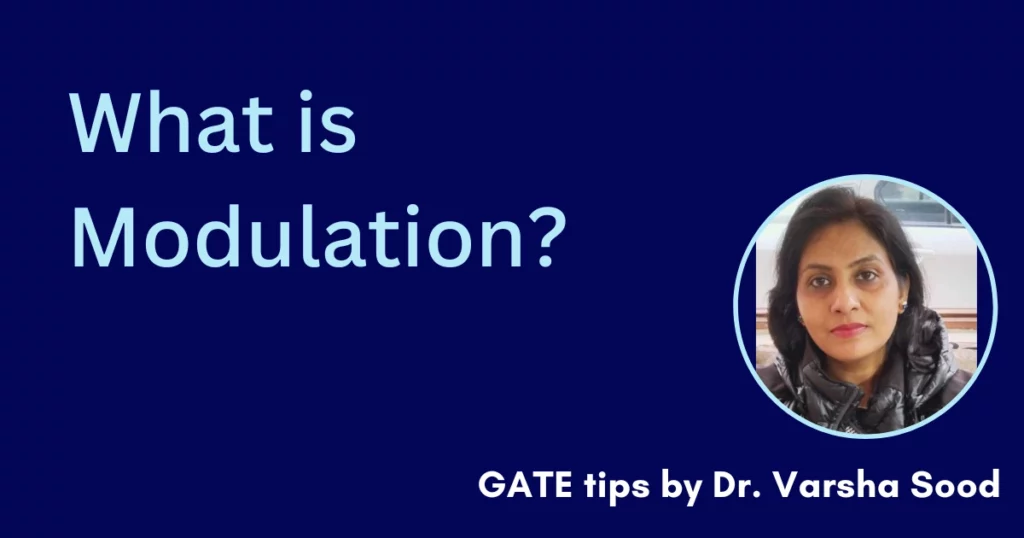In the modern era of communication, the study of modulation is very important. Nowadays, people want seamless connectivity , high speed, efficient and secure communication. For this purpose the study of modulation plays a very essential role.
Communication System
The communication system is a systematic arrangement of various components which helps in the transfer of information from the source to the destination.
The block diagram of communication system is shown below.

From this block diagram, we can see that there are various components which includes transmitter, channel, receiver, transducer, etc.
This block diagram shows that first the message originating from the source is fed to the input transducer, the output of which goes to the transmitter, where modulation takes place. The modulated signal then passes through the channel to arrive at the receiver.
Finally the message reaches the destination.
Now, let us understand, what is modulation?
You can watch a quick YouTube video or read along.
What is Modulation ?
Modulation is the process of varying one or the other parameter of the carrier signal in accordance with the message signal.
Modulation consists of two types of signals, carrier signal and the message signal.
i) Message signal :- Message signal is also known as baseband signal, information signal or the modulating signal. Baseband signal means a low frequency signal.
ii) Carrier signal :- Carrier signal is a high frequency signal. A particular parameter of the carrier signal is varied in accordance with the instantaneous values of the baseband signal.
The modulated signal is the signal generated as a result of modulation of carrier signal by the baseband signal . This modulated signal is also called as passband signal.
Modulation is classified as :-
i) Analog Modulation :- If the message signal is of analog type, then the modulation is called as analog modulation.
ii) Digital Modulation :- If the message is of digital nature, it is called digital modulation.
Features of Modulation
i) Change :- Change is the prime feature of modulation.
The message signal changes one of the characteristics of the carrier signal.
Carrier signal is of two types, namely :-
i) Continuous wave
ii) Pulse wave
i) Continuous Wave :-The characteristics of a continuous (sinusoidal) wave are amplitude, frequency and phase.
ii) Pulse wave :- Pulse wave is characterized by position, width and the amplitude.
In modulation at one time usually only one parameter is changed , keeping other parameters constant.
ii) Frequency translation :- The frequency translation feature of modulation refers to the shift in the frequency of a signal. The lower baseband frequency is shifted to the higher carrier frequency. Here the fundamental message frequency is very less as compared to the carrier frequency.
fm << fc
where, fm – fundamental frequency (highest frequency component present in case of multitone message signal )
fc – carrier frequency
These were the features of modulation.
Why there is need for modulation ?
i) Reduction in the height of antenna – For the transmission of radio signals, the antenna height must be in proportion with the wavelength of the signal being transmitted. The low frequency signals have relatively higher wavelengths , hence require larger antenna heights ( in the range of several kilometers for the voice signals )
ii) Multiplexing – In multiplexing , two or more channels can be transmitted over the same communication channel .
iii) To reduce the effects of noise – The effects of noise is reduced to a great extent.
iv) Narrow-banding of the signal – An antenna dimension suitable for use at one end of the frequency range may fall too short or too large for use at another end of the frequency range in case of a wideband signal. An antenna of variable height is hence required to transmit such a signal. Modulation presents a solution to this problem by narrow banding the signal.
BW= fH– fL
\frac{f_{H}}{f_{L}}> > 1(WB)v) Increases the range of communication:- Modulation helps in increasing the effective power of the signal , thereby allowing it to travel through longer distance. The lower frequency baseband signals get heavily attenuated otherwise.
vi) Avoids mixing of signals by frequency allocation :- Without modulation the mixing of signals may happen. For example in the voice signals falling in the frequency range of 300 Hz to 3.5 KHz, if sent over a common channel, say air, would interfere with each other. The receiver designated for a given signal may not be able to extract the desired signal from the mixed up signals. This problem of interference is also taken care of by allocating different frequency to each of the voice signals by the help of modulation.
In this way , we conclude our journey of modulation. By making use of a high frequency signal to carry the information, modulation ensures that our messages, music, and data traverse through the different channels with enhanced protection and efficiency.
Hope, so this article has cleared all your doubts regarding modulation and justified the need for modulation.
Best Course for Communications
By Dr. Varsha Vimal Sood


